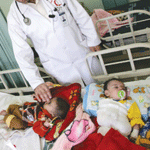Reprinted from New America Media
Forget about oil, occupation, terrorism or even Al Qaeda. The real hazard for Iraqis these days is cancer. Cancer is spreading like wildfire in Iraq. Thousands of infants are being born with deformities. Doctors say they are struggling to cope with the rise of cancer and birth defects, especially in cities subjected to heavy American and British bombardment.

|
|
Iraqi Dr. Aiman Qeis cares for children at Falluja General Hospital west of Baghdad. Doctors are reporting a spike in birth defects. Muhannad Fala’ah/Getty Images |
The cancer rate in the province of Babil, south of Baghdad has risen from 500 diagnosed cases in 2004 to 9,082 in 2009 according to Al Jazeera English.
In Basra there were 1885 diagnosed cases of cancer in 2005. According to Dr. Jawad al Ali, director of the Oncology Center, the number increased to 2,302 in 2006 and 3,071 in 2007. Dr. Ali told Al Jazeera English that about 1,250-1,500 patients visit the Oncology Center every month now.
Not everyone is ready to draw a direct correlation between allied bombing of these areas and tumors, and the Pentagon has been skeptical of any attempts to link the two. But Iraqi doctors and some Western scholars say the massive quantities of depleted uranium used in U.S. and British bombs, and the sharp increase in cancer rates are not unconnected.

|
|
The feet of Zahra Muhammad, age 4 years old, who suffers from a birth defect, are seen on November 12, 2009 in the city of Falluja west of Baghdad, Iraq. Birth defects have soared in Fallujah, which was the site of two major battles between the U.S military and insurgents after the invasion of Iraq according to Iraqi doctors. Muhannad Fala’ah/Getty Images Europe |
Iraqi doctors say cancer cases increased after both the 1991 war and the 2003 invasion.
Abdulhaq Al-Ani, author of “Uranium in Iraq,” told Al Jazeera English that the incubation period for depleted uranium is five to six years, which is consistent with the spike in cancer rates in 1996-1997 and 2008-2009.
There are also similar patterns of birth defects among Iraqi and Afghan infants who were also born in areas that were subjected to depleted uranium bombardment.
Dr. Daud Miraki, director of the Afghan Depleted Uranium and Recovery Fund, told Al Jazeera English he found evidence of the effect of depleted uranium in infants in eastern and south-eastern Afghanistan. “Many children are born with no eyes, no limbs, or tumors protruding from their mouths and eyes,” said Dr. Miraki.
It’s not just Iraqis and Afghans. Babies born to American soldiers deployed in Iraq during the 1991 war are also showing similar defects. In 2000, Iraqi biologist Huda Saleh Mahadi pointed out that the hands of deformed American infants were directly linked to their shoulders, a deformity seen in Iraqi infants.
Many U.S. soldiers are now referring to Gulf War Syndrome #2 and alleging they have developed cancer because of exposure to depleted uranium in Iraq.
But soldiers can end their exposure to depleted uranium when their service in Iraq ends. Iraqi civilians have nowhere else to go. The water, soil and air in large areas of Iraq, including Baghdad, are contaminated with depleted uranium that has a radioactive half-life of 4.5 billion years.
Dr. Doug Rokke, former director of the U.S. Army’s Depleted Uranium Project during the first Gulf War, was in charge of a project of decontaminating American tanks. He told Al Jazeera English that “it took the U.S. Department of Defense in a multi-million dollar facility with trained physicists and engineers, three years to decontaminate the 24 tanks that I sent back to the U.S.”
And he added, “What can the average Iraqi do with thousands and thousands of pounds of trash and destroyed vehicles spread across the desert and other areas?”
According to Al Jazeera, the Pentagon used more than 300 tons of depleted uranium in 1991. In 2003, the United States used more than 1,000 tons.






Leave a Reply